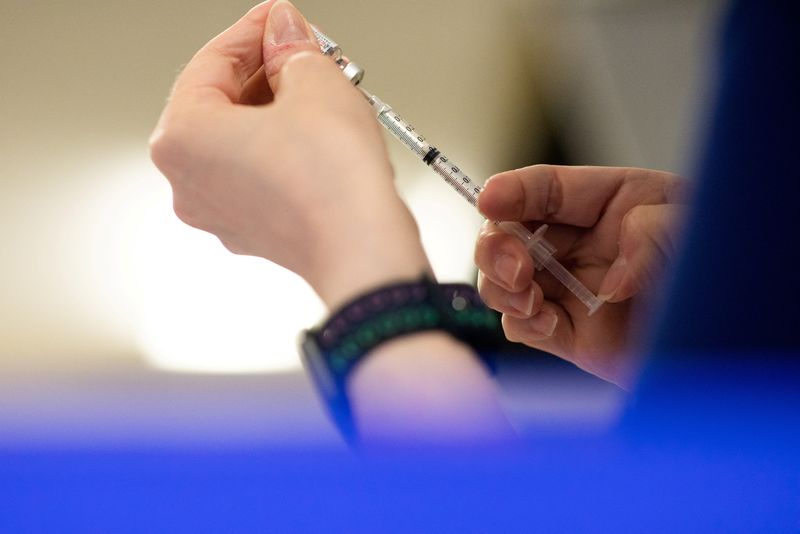
[ad_1]

© Reuters. FILE PHOTO: A nurse fills up syringes with the coronavirus disease (COVID-19) vaccines for residents who are over 50 years old and immunocompromised and are eligible to receive their second booster shots in Waterford, Michigan, U.S., April 8, 2022. REUTE
By Deena Beasley and Nancy Lapid
(Reuters) – The World Health Organization and the U.S. Centers for Disease Control and Prevention are tracking a new, highly mutated lineage of the virus that causes COVID-19.
Six cases in four countries have been detected since late July. Scientists are keeping an eye on the new lineage, named BA.2.86, because it has 36 mutations that distinguish it from the currently-dominant XBB.1.5 variant.
So far there is no evidence that BA.2.86 spreads faster or causes more serious illness than previous versions. The CDC said its advice on protecting yourself from COVID remains the same.
What is new about COVID?
COVID infections and hospitalizations have been rising in the U.S., Europe and Asia, with more cases in recent months attributed to the EG.5 “Eris” subvariant, a descendant of the Omicron lineage that originally emerged in November 2021.
Over the past few days, public health authorities have documented one case each of BA.2.86 in the United States, the UK, and Israel, and three cases in Denmark.
What do scientists say about BA.2.86?
BA.2.86 stems from an “earlier branch” of the coronavirus, so it differs from the variant targeted by current vaccines, explained Dr. S. Wesley Long, medical director of diagnostic microbiology at Houston Methodist Hospital.
He said it remains to be seen whether BA.2.86 will be able to out-compete other strains of the virus or have any advantage in escaping immune responses from prior infection or vaccination.
But many countries have drastically reduced testing of patients and their efforts to analyze the genomes of the viruses causing new COVID cases. In that situation, the trajectory of BA.2.86 “doesn’t look good right now,” given the speed at which new cases are being identified, said Dr. Eric Topol, a genomics expert and director of the Scripps Research Translational Institute in La Jolla, California.
Its many mutations make BA.2.86 “radically different in its structure” compared to earlier variants, Topol said.
The main question, he added, is whether BA.2.86 will turn out to be highly transmissible.
Do the new variants make people sicker?
U.S. emergency department visits and hospitalizations for COVID remain low, but have been rising since early July, according to data on the CDC website. So far, however, doctors have been reporting that patients seen in recent weeks, as the Eris variant has been spreading, are not as sick as those they treated during earlier waves of the pandemic.
Wider spread of BA.2.86 would likely cause more illness and death in vulnerable populations, Topol said.
It is too soon to know whether BA.2.86 will cause more-severe illness.
“Based on the available evidence, we do not yet know what risks, if any, (BA.2.86) may pose to the public’s health beyond what has been seen with other currently circulating lineages,” a CDC spokesperson said.
Will vaccines protect against new variants?
Due to the waning of the pandemic, it may have been a year or more since many people were either previously infected or vaccinated against COVID.
“The vaccine is still going to provide you great defense against illness and death,” Long said.
Updated COVID booster shots now being developed have been designed to target the Omicron subvariant XBB.1.5.
Moderna (NASDAQ:) said preliminary trial data suggest its latest version of the vaccine shows promise against Eris and a related variant called Fornax, which has begun to circulate in the U.S.
Pfizer Inc (NYSE:) has said its updated COVID-19 shot showed neutralizing activity against the Eris subvariant in a study conducted on mice.
[ad_2]